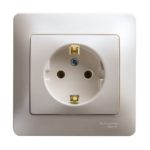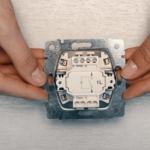Correct installation of sockets allows to ensure a comfortable location of portable lighting fixtures and household appliances. To complete the work, you need to know the principles / rules of safety and correctly plan the location of the food outlets.
Important conditions for safe installation

SNiP, GOST and PUE regulate a number of rules that must be observed when performing electrical work.
- Before installing switches and sockets, according to the rules, you should turn off the general input machine for the whole house or apartment. Thus, the master breaks both the phase and zero, which provides greater safety.
- Before starting the installation, using the indicator, check the absence of voltage of 220 V.
- Food points in rooms are located 60 cm from the floor (minimum). If there are children of any age in the house, the installation height changes to 1.8 m. In public catering places, the socket is placed 1.3 m from the floor.
- For a skirting board with a European standard cover, it is allowed to maintain a height of 30 cm from the bottom of the room.
- It is undesirable to carry out installation work and make power points less than 50 cm from grounded equipment in bathrooms (radiators, fittings, sinks, PVC pipes).
- In plumbing rooms, wiring should only be hidden.
- According to the rules, for every 8-10 m2 of the room there must be one element of electrical power.
- The switches are mounted at least 90 cm from the floor and 10 cm from the door frame.
- If work is carried out in the kitchen, sockets and switches are located at least 50 cm from the gas line.
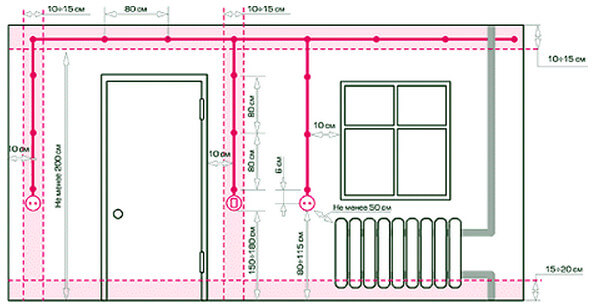
Violation of established norms and requirements threatens the master with the creation of emergency situations.
Types of sockets
To equip a single-phase electricity line with a voltage of 220, the following types of structures are used:
- With a side earthing contact (C 2a). Their design assumes the presence of an additional terminal to which the green core is connected. More often, the installation of a socket of this type is performed for powerful household appliances (electric stove, boiler).
- Without grounding (C 1a). Conventional sockets rated for a maximum operating current of 10 A. They can handle voltages up to 250 V and do not need to be grounded.
- Devices with a grounding lug. It is mounted depending on the type of plug to be connected. Such elements have the C 3a standard.
Additionally, sockets are classified into types according to the type of construction:
- External (overhead). Designed for self-assembly on the walls of wooden log cabins, panels. If the master does not know how to install an outlet in such buildings, it is worth following the fire safety rules. It is strictly forbidden to cut food points into a tree.
- Built-in (internal). They are used for installation in walls made of monolith, brick, foam concrete, drywall.
Additionally, the sockets are divided into types according to the method of attaching the wires in them:
- With spring terminals. The stripped wires are inserted into a special technical hole and fixed automatically.
- With a screw. The wires are pressed against the terminals by tightening a small fastener.
There are also floor-standing mini-columns with which you can output from 2 to 6 power points at the same time. They can be added if you need to connect a large number of equipment in one place.
Before making an outlet, it is important to consider that the installation of a power point without grounding can be carried out using a two-wire double cable (with two wires inside). Installation of an earthed element is carried out using three-core (triple) cables. The yellow wire is intended for joining the required terminals with the apartment ground.
Installation technology
Before installing the sockets, you need to prepare all the necessary tools:
- screwdrivers (flat and cross);
- perforator and a crown for it 70 mm;
- wall chaser or grinder;
- side cutter or sharp knife for removing the cable sheathing;
- building level for the installation of outlets;
- tape measure and marker;
- hammer and chisel;
- putty knife;
- containers for the preparation of mortar (alabaster, gypsum, putty).
It is better to perform noisy dirty work on wall chipping on weekdays from 10:00 to 17:00. This way you can minimize possible conflicts with neighbors. If there are small children nearby, take a lunch break.
Sockets are installed in one of the ways - overhead or built-in.
Outdoor installation
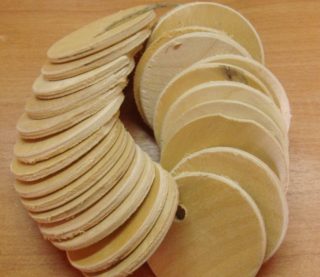
To put an outlet on a wooden wall, you need to adhere to the following work scheme:
- With the help of a cable channel, an electric cable is connected to the location of the future power point. It is important to cut its length with some margin for installation.
- You need to attach a socket box to the wall on a special panel using self-tapping screws.
- The cover-panel of the structure is removed and connected to the desired terminals of the core of the cable freed from the braid. Here it is worth considering the marking: "L" means a phase wire, "N" - zero.
- With the help of special lugs, the polymer housing of the socket is screwed onto the installed socket. To prevent it from pinching the power cable, you need to break out the technical window on the side. The whole structure is fixed with a screw.
It remains to close the wires along the wall with a cover from the cable channel.
Indoor installation
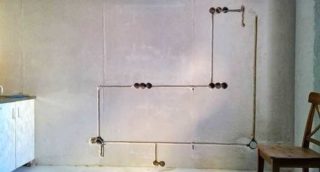
To install the socket into the wall, you first need to prepare a socket for it: grind the walls and form a recess in the partition. Before starting work, markings are applied to the walls if the power point is installed in a new place. Stages of further work:
- Channels for the cable are made strictly along the outlined lines. First, cuts are formed on both sides, and then the remnants of the concrete are knocked out with a hammer and chisel.
- The nest for the glass is made with a perforator with a crown. The remains of the monolith are knocked out again, in parallel trying on the element in depth. It should not protrude above the plane of the wall.
- A supply cable is pulled along the finished strobe and its end is inserted into the technical connectors of the glass, bringing out the end of 10-15 cm. This with a margin should be enough for the connection.
- With the help of alabaster solution, a glass is mounted in the nest, controlling the level of its protrusion above the plane of the wall. All gaps around the glass are closed with mortar, leveling the surface of the partition. Alabaster dries for 20-30 minutes. Putty and gypsum longer (up to a day, depending on how much mortar is used).
- Release the power cable from the braid by 10 cm, and each exposed wire (red / brown, blue / white, yellow / yellow-green) by 1 cm.
- They are connected to the socket terminals according to the phases. Towards zero - blue or white (depending on the manufacturer). To phase - red (brown). To ground - green (yellow-green).
- Insert the socket into the glass and fix it by means of sliding legs. It is also important to control the evenness of the element in level. Otherwise, the feed point will be skewed.
- It remains to install the outer panel and frame on the screw.
It is very easy to plug the socket into the drywall. It has special clamping clips.The socket is inserted into the socket. The gypsum plasterboard base is quite fragile, so when working with a puncher, you should not put too much pressure on it.
Dismantling the old socket
When carrying out repairs, it is often necessary to change old food outlets for new ones, especially in Khrushchev or stalinka, panel houses of the old type. Sometimes such sockets are built into the wall without a socket. Here the master must act in the following sequence:
- The power is cut off at the switchboard.
- The socket panel is removed by unscrewing the fasteners.
- Using a screwdriver, the master disconnects the wires from the terminals and removes the old structure.
- It is important to free a part of the supply cable in order to freely form a socket for installing a new glass.
- Otherwise, all actions are performed by analogy with installing an internal (built-in) power point.
If the supply cable is short, you can lengthen it. All connections are carefully insulated.
How to make grounding with your own hands

Sometimes you have to do the grounding to the outlet yourself. The work is performed in this way:
- A three-core cable runs from the general junction box or from the shield along the strobes to the designated area. The cross-section of each wire must be at least 2.5 mm2.
- The terminal block should be fixed on a special DIN rail. The vein of "earth" will be connected to it. The color of the ground wire is always green or yellow-green.
- The joints of the wires when installing the sockets are well insulated.
After the work has been done, it remains to fix the grounded outlet.
Installation of sockets and switches in a panel house

If you have to mount power points on concrete walls in panel houses, it is important to take into account that monolithic blocks contain reinforcement inside. Therefore, it is better to use a metal detector when chasing. It is prohibited to make channels in supporting structures.
To screw a new outlet into the place of the old one, which is connected to the power point in the neighboring apartment through the wall, experts recommend proceeding in this way:
- Move the location of the new one a little, and foam or plaster the junction with the neighbors. Their food point can remain in its old place.
- Extend one more power point along the strobes from the existing one.
- Route the new cable away from the junction box for mounting the sockets.
- Connect power to the new power point from the breaker.
- Place the glasses in the old place on a layer of alabaster.
In the same way, you can connect the light in the room, bring the wiring to the switches.
All electrical work should be done with extreme caution. If the master realizes that he will not cope with the task, it is better to install an electrician with the help of an experienced professional who has permission to provide these types of services.



